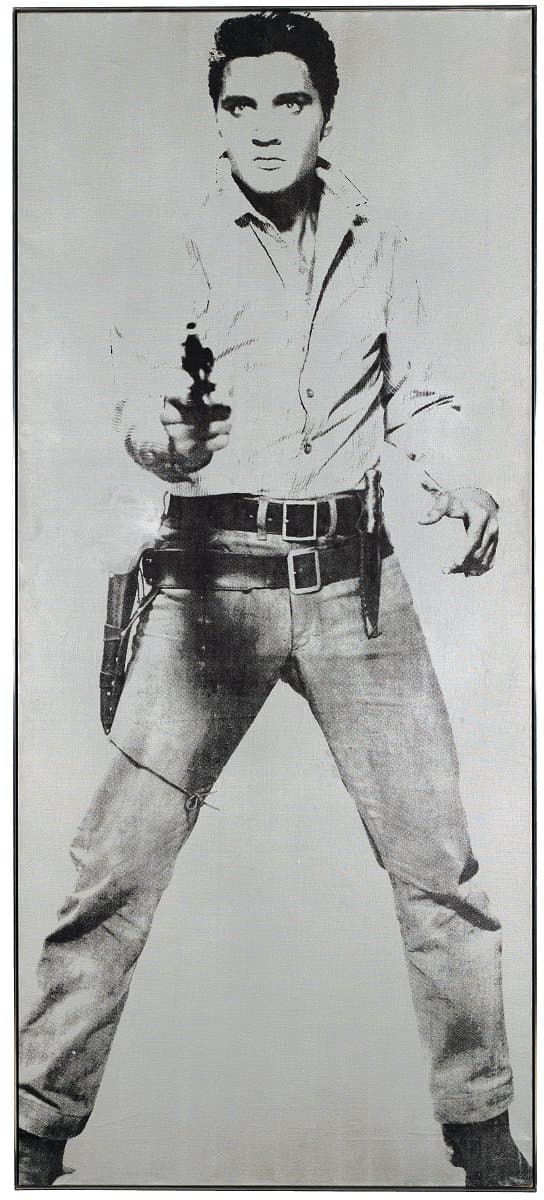

Andy Warhol
Learn moreElvis 1963
© The Andy Warhol Foundation for the Visual Arts, Inc./ARS. © Elvis Presley Enterprises Inc. Licensed by Copyright Agency Purchased 1973
More detail | PermalinkElvis 1963 is one of a series of screenprinted canvases produced by Andy Warhol of the popular American singer Elvis Presley. Warhol’s first forays into screenprinting were prompted by the ‘beautiful face’ and death of Marilyn Monroe in August 1962; at this time he also used headshots of actors and films stars such as Troy Donahue and Warren Beatty, as well as repeat copies of Presley’s head. Of his process, Warhol later recalled:
the rubber‑stamp method I’d been using to repeat images suddenly seemed too homemade; I wanted something stronger that gave more of an assembly‑line effect. With silkscreening you pick a photograph, blow it up, transfer it in glue onto silk, and then roll ink across it so the ink goes through the silk but not through the glue. That way you get the same image, slightly different each time. It all sounds so simple—quick and chancy. I was thrilled with it.[1]
In 1963 Warhol established a studio in an abandoned fire station in East 87th Street and hired Gerald Malanga, a young poet, to assist him with his screenprinting. He began work on a head of film star Elizabeth Taylor and a full‑length portrait of Presley. The image of Elvis was taken from a publicity still for the film Flaming Star (1960, Twentieth Century Fox). His new studio, according to Warhol:
was pretty scary. You literally had to hopscotch over holes in the floor. And the roof leaked. But we didn’t really notice all that much, we were busy getting the Elvises and the Liz Taylor silkscreens ready to ship out to California [for his exhibition at Ferus Gallery, Los Angeles]. One night that summer there was a terrible thunderstorm and when I came in the next morning, the Elvises were sopping wet—I had to do them all over again.[2]
The image was screenprinted 28 times in black paint onto a roll of silver‑painted canvas in various combinations—singly, superimposed doubly and triply, and in pairs.[3] This whole roll of printed canvas was sent off to the Ferus Gallery with a set of stretchers, all of the same height but three different widths. In the absence of instructions from Warhol, Irving Blum of Ferus Gallery matched the stretchers to the images, producing five single images (including the NGA’s Elvis), six superimposed images and two diptychs of paired images—one panel of each diptych having additional colour to the screened images. When Warhol visited Los Angeles to attend the opening of his exhibition he described the thrill of seeing:
the Elvises in the front room and the Lizes in the back. Very few people on the [west] Coast knew or cared about contemporary art, and the press for my show wasn’t too good. I always have to laugh, though, when I think of how Hollywood called Pop Art a put‑on! Hollywood?? I mean when you look at the kind of movies they were making then—those were supposed to be real???[4]
This was a busy period with the artist’s first two solo exhibitions on the west and east coasts. In 1962 Warhol had shown his Campbell’s soup can paintings at the Ferus Gallery and this exhibition—along with his first at the Stable Gallery, New York, in which the soup cans featured along with images of Coke bottles, Marilyn Monroe and Elvis Presley—prompted much criticism of the artist and Pop tendencies more generally.[5] Elvis also shows the signs of an extreme reaction: on the left hand side, just visible through subsequent repairs, is the damage from a penknife attack in 1963.[6]
Michael Lloyd and Michael Desmond[7]
[1] Andy Warhol and Pat Hackett, POPism: The Warhol ’60s, Harcourt Brace Jovanovich, New York and London, 1980, p 22.
[2] As above, p 27.
[3] Gerald Malanga, who assisted with the production of the Elvis series, notes that: ‘On the Elvis Presley silkscreens the image slightly imposed over itself, maybe three or four times. That was an idea I picked up from a photographic process and introduced to Andy. Cecil Beaton had done something like that in one of his early photograph books—a kind of trick stop‑motion effect,’ in Jean Stein with George Plimpton, Edie: An American biography, Alfred A Knopf, New York, 1982, p 206.
[4] Warhol and Hackett, p 42.
[5] It was also included in The New Realists exhibition at the Sidney Janis Gallery, New York.
[6] In 1963, according its former owner Jan van der Marck, ‘it was attacked with a penknife by a maniac at the Castelli Gallery and subsequently restored’. Correspondence of 10 December 1973 with the National Gallery of Australia, NGA file 72/0195.
[7] Adapted and updated from Michael Lloyd and Michael Desmond, European and American paintings and sculptures 1870–1970 in the Australian National Gallery, Australian National Gallery, Canberra, 1992, pp 326–8, by Lucina Ward.

